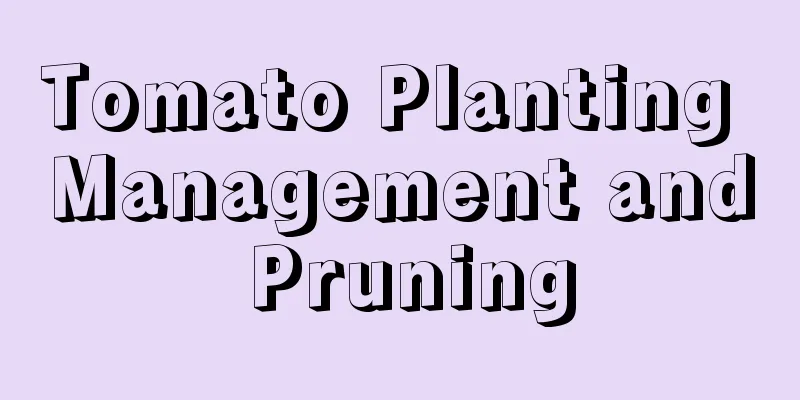Tomato Planting Management and Pruning

|
As a plant of the Solanaceae family, tomatoes have strict requirements for growing conditions and management, so they may be challenging for some growers. Growing tomatoes is not an easy task. Many vegetable farmers' tomato plants tend to grow poorly or even die. Even if the plant survives, its fruit may be infected with diseases, causing it to rot. In addition, tomato leaves are also susceptible to a variety of diseases and pests, among which gray mold is particularly significant. Below we will learn about tomato planting management and pruning. 1. Tomato planting management Pruning and branching: When the tomato seedlings grow to 6 to 8 true leaves, the side branches on both sides should be removed, leaving only the main branches. This practice helps to concentrate nutrients on the main branches, promoting stronger plant growth and full fruit development. Management during fruit setting period: As the main branches reach a certain height and begin to bloom, the plant enters the fruit-setting period. At this stage, attention should be paid to the following aspects: Control plant growth: Prune at the right time to avoid excessive growth. Maintain ventilation and light: Reasonably adjust the plant structure to ensure good ventilation and light conditions. Water management: irrigate regularly to ensure adequate water supply , and pay attention to drainage to prevent water accumulation at the roots. Temperature and humidity regulation: Provide suitable temperature and humidity to create the best growth environment for plants. Soil management: Loosen the soil regularly to promote root development, and apply fertilizer in time to supplement the nutrients needed by the plants. Fruit preservation period management: When fruits begin to form, the plant enters the fruit retention period. During this period, the following points should be noted: Reasonable flower and fruit thinning: According to the carrying capacity of the plant, appropriately remove some flowers and young fruits to avoid affecting the fruit quality due to excessive load. Pest and disease control: Check the health of the plants regularly, remove pests and diseases in a timely manner, and keep the plant growth environment clean. Fruit support: Provide support for the fruit to prevent it from directly contacting the ground, reducing the risk of rot and damage. 2. Tomato pruning management Pruning tomatoes is an important step in ensuring healthy growth and increasing yield. Determining how many growing points to retain on each tomato plant is key to pruning. Common pruning methods include: Single stem pruning: For indeterminate tomato varieties , keep only the main stem and remove all side branches. Single-stem half-pruning: In addition to the main stem, retain an extra side branch and top it after it produces 2-3 fruits. This is suitable for tall plant varieties with unlimited growth and limited growth. Double-stem pruning: Similar to single-stem half-pruning, but the retained side branches are not topped, allowing them to continue growing while removing axillary buds. It is suitable for limited-growth tomatoes, especially dwarf varieties. Multi-stem pruning: retain 3-4 stems, one of which is the main stem, for short-vine early-maturing varieties. When choosing a pruning method, consider the growth characteristics of the tomato variety and the planting density. If there are not enough seedlings, double-stem or multi-stem pruning can be used; if the planting density is high, consider single-stem pruning. When to do the first pruning: The first pruning is usually done 10 to 15 days after the tomatoes are established, when the side branches reach 5-6 cm in length. Before this, the side shoots of the seedlings can be retained to produce nutrients and promote root growth. However, pruning should not be done too late, so as not to affect the normal growth of the plant. Things to note when pruning: Pruning can cause plant trauma and increase the risk of disease spread. Therefore, pruning should be done in the morning after the dew has dried, and pruning in the morning and evening should be avoided, because the wounds caused by pruning at night are not easy to heal on the same day. If you prune during the high temperature and low humidity at noon, the side branches will easily become dehydrated, making the operation inconvenient. If diseased plants are found, especially those with virus diseases, healthy plants should be pruned first, and then the diseased plants should be handled. Wash your hands with soap after the operation to prevent the virus from spreading through tobacco. The above are the key points of tomato planting management and pruning. Although tomato planting is prone to diseases and pests, as long as daily management work is done well, the yield and quality can still be improved.
|
>>: Green plant maintenance knowledge and methods
Recommend
Cultivation methods and precautions of copper coin grass
1. Flower soil The pennywort is suitable for grow...
Best time to prune orange trees
Orange Tree Pruning Time Orange trees need to be ...
The efficacy and contraindications of wormwood
1. Efficacy and Function 1. Antibacterial: Mugwor...
What is rooting water and how to use it
What is root water? Rooting water refers to the w...
Can the osmanthus tree be placed in the bedroom?
1. Can it be placed in the bedroom? If you want t...
How to care for pineapple flowers? How to care for pineapple flowers at home
Bromeliad Growth Conditions Pineapple flowers lik...
When is the best season to plant wisteria?
Wisteria planting season and time Wisteria planti...
When is the best time to prune azaleas?
Rhododendron pruning During the maintenance of az...
Are the fruits of ornamental plants edible?
Are the fruits of ornamental plants edible? 1. Le...
The value of Vinca
The ornamental value of Vinca Vinca has a high or...
Radish growth environment conditions and characteristics
Radish Growth Environmental Conditions and Requir...
Can peppers survive if their leaves wilt after being flooded? (How to save peppers if their leaves wilt after being flooded?)
Is there any way to save the pepper leaves that h...
How to reproduce Tang fan
The propagation method of Tang fan: sowing The so...
Difference Between Raspberries and Mulberries
The difference between raspberries and mulberries...
Can purple leaf spider plant be hydroponically cultivated? Methods and key points of water cultivation
Can purple leaf spider plant be hydroponically cu...









